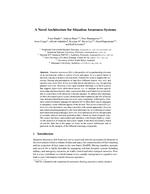A Novel Architecture for Situation Awareness Systems
From International Center for Computational Logic
A Novel Architecture for Situation Awareness Systems
Franz BaaderFranz Baader, Andreas BauerAndreas Bauer, Peter BaumgartnerPeter Baumgartner, Anne CreganAnne Cregan, Alfredo GabaldonAlfredo Gabaldon, Krystian JiKrystian Ji, Kevin LeeKevin Lee, David RajaratnamDavid Rajaratnam, Rolf SchwitterRolf Schwitter
Franz Baader, Andreas Bauer, Peter Baumgartner, Anne Cregan, Alfredo Gabaldon, Krystian Ji, Kevin Lee, David Rajaratnam, Rolf Schwitter
A Novel Architecture for Situation Awareness Systems
In Martin Giese and Arild Waaler, eds., Proceedings of the 18th International Conference on Automated Reasoning with Analytic Tableaux and Related Methods (Tableaux 2009), volume 5607 of Lecture Notes in Computer Science, 77-92, 2009. Springer
A Novel Architecture for Situation Awareness Systems
In Martin Giese and Arild Waaler, eds., Proceedings of the 18th International Conference on Automated Reasoning with Analytic Tableaux and Related Methods (Tableaux 2009), volume 5607 of Lecture Notes in Computer Science, 77-92, 2009. Springer
- KurzfassungAbstract
Situation Awareness (SA) is the problem of comprehending elements of an environment within a volume of time and space. It is a crucial factor in decision-making in dynamic environments. Current SA systems support the collection, filtering and presentation of data from different sources very well, and typically also some form of low-level data fusion and analysis, e.g., recognizing patterns over time. However, a still open research challenge is to build systems that support higher-level information fusion, viz., to integrate domain specific knowledge and automatically draw conclusions that would otherwise remain hidden or would have to be drawn by a human operator. To address this challenge, we have developed a novel system architecture that emphasizes the role of formal logic and automated theorem provers in its main components. Additionally, it features controlled natural language for operator I/O. It offers three logical languages to adequately model different aspects of the domain. This allows to build SA systems in a more declarative way than is possible with current approaches. From an automated reasoning perspective, the main challenges lay in combining (existing) automated reasoning techniques, from low-level data fusion of time-stamped data to semantic analysis and alert generation that is based on linear temporal logic. The system has been implemented and interfaces with Google-Earth to visualize the dynamics of situations and system output. It has been successfully tested on realistic data, but in this paper we focus on the system architecture and in particular on the interplay of the different reasoning components. - Forschungsgruppe:Research Group: AutomatentheorieAutomata Theory
@inproceedings{ SAILpaper,
author = {Franz {Baader} and Andreas {Bauer} and Peter {Baumgartner} and Anne {Cregan} and Alfredo {Gabaldon} and Krystian {Ji} and Kevin {Lee} and David {Rajaratnam} and Rolf {Schwitter}},
booktitle = {Proceedings of the 18th International Conference on Automated Reasoning with Analytic Tableaux and Related Methods (Tableaux 2009)},
editor = {Martin {Giese} and Arild {Waaler}},
pages = {77--92},
publisher = {Springer-Verlag},
series = {Lecture Notes in Computer Science},
title = {A Novel Architecture for Situation Awareness Systems},
volume = {5607},
year = {2009},
}
